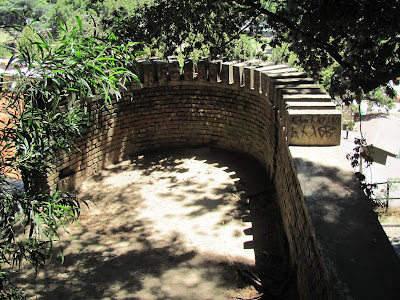This trip has been a great experience, it has been interesting as I spend more time at various plazas. I see landscape elements I would do differently, as well as, I have seen many great ideas.
The one thing that stands out about all of the designed landscapes I have seen so far, is the lack of professionally educated landscape designers and designs. Chile is just now starting to offer degrees in landscape architecture and horticulture at very few and select colleges and universities.
This lack of understanding of basic design principles and/or basic horticulture practices is sad to see because in this area of Chile the land is very fertile and green and can grow just about anything with little or no skill. There is an abundance of beautiful trees and plants. I see many attempts to create a beautiful concept, but overall the final effect was not completely achieved due to a lack of basic landscape knowledge and skill. For example:
The one thing that stands out about all of the designed landscapes I have seen so far, is the lack of professionally educated landscape designers and designs. Chile is just now starting to offer degrees in landscape architecture and horticulture at very few and select colleges and universities.
This lack of understanding of basic design principles and/or basic horticulture practices is sad to see because in this area of Chile the land is very fertile and green and can grow just about anything with little or no skill. There is an abundance of beautiful trees and plants. I see many attempts to create a beautiful concept, but overall the final effect was not completely achieved due to a lack of basic landscape knowledge and skill. For example:

Four different kinds of plants were installed in a very small area with little thought about how they will appear when they are fully grown. Is the space large enough to accommodate each plant and its needs for space, water, and sun?
In addition, these same four plant species were never used again in the rest of the plaza. Repetition of plant material is a basic design principle that was ignored.
Here is another example:
In addition, these same four plant species were never used again in the rest of the plaza. Repetition of plant material is a basic design principle that was ignored.
Here is another example:
Notice the Palm tree in the foreground. It does not work here, in fact, it distracts from the beauty and design of the other trees. Because there is only one tree of its kind here it does not belong. It appears that it was an extra tree that someone just decided to plant in that spot.
Yet another problem with this Palm tree:
Yet another problem with this Palm tree:
It was obviously planted after the other trees had matured and is directly under the canopy of a larger tree. No planning regarding the future growth of the palm was considered. The palm tree has room to grow right now, but in five years it will become a problem. It will collide with the canopy of the other tree.
I see this same pattern of design problems over and over again. I see a house with a small yard space and a big old oak tree growing that completely hides the house and ten different kinds of plants all competing for the same area.
Note: I want to clarify that if you take a short drive through any neighborhood in Utah, you will see the same problems. In the US, professional landscapers will try to address these issues. I am in no way trying to put down Chile. As I have stated earlier, there are no landscape professionals here. I have seen many beautiful buildings and other structures that obviously had a professional Architect involved in the design and planning, but Building Architects and Landscape Architects are not the same thing.
Note: I want to clarify that if you take a short drive through any neighborhood in Utah, you will see the same problems. In the US, professional landscapers will try to address these issues. I am in no way trying to put down Chile. As I have stated earlier, there are no landscape professionals here. I have seen many beautiful buildings and other structures that obviously had a professional Architect involved in the design and planning, but Building Architects and Landscape Architects are not the same thing.












